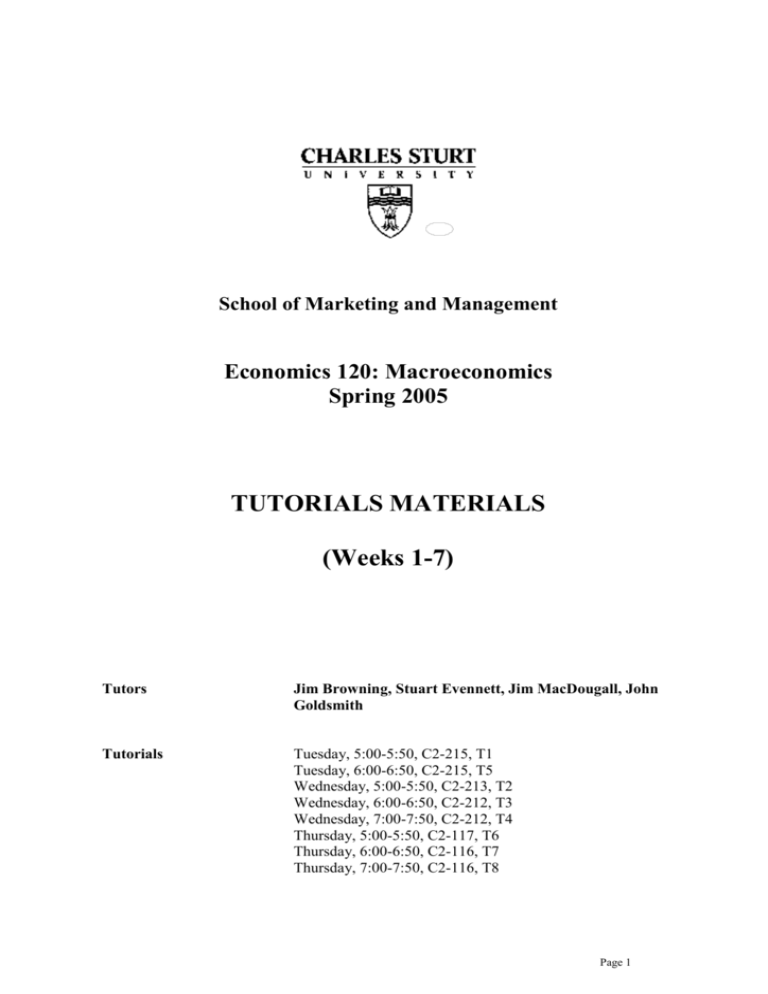Econ120Int Tutorials..
advertisement

School of Marketing and Management Economics 120: Macroeconomics Spring 2005 TUTORIALS MATERIALS (Weeks 1-7) Tutors Jim Browning, Stuart Evennett, Jim MacDougall, John Goldsmith Tutorials Tuesday, 5:00-5:50, C2-215, T1 Tuesday, 6:00-6:50, C2-215, T5 Wednesday, 5:00-5:50, C2-213, T2 Wednesday, 6:00-6:50, C2-212, T3 Wednesday, 7:00-7:50, C2-212, T4 Thursday, 5:00-5:50, C2-117, T6 Thursday, 6:00-6:50, C2-116, T7 Thursday, 7:00-7:50, C2-116, T8 Page 1 SUBJECT PROGRAM LECTURE LECTURE TOPIC READINGS Week 1 Introduction to macroeconomics Jackson, Chapters 4 and 5 Week 2 Aggregate expenditures model Jackson, Chapters 5 and 6 Week 3 AE model and the multiplier Jackson, Chapters 6 and 7 Week 4 Aggregate demand and aggregate supply model Jackson, Chapter 8 Week 5 Investment and savings Mansfield and Yohe, Chapter 15, pp 486-502. Week 6 Review and mid-term 1 Week 7 Fiscal policy Jackson, Chapters 9 Semester break Week 8 Money and the banking system Jackson, Chapters 10 and 11 Week 9 Monetary policy Jackson, Chapter 12 Week 10 Unemployment and inflation Jackson, Chapter 14 Week 11 Economic growth Jackson, Chapter 16 Week 12 Review and mid-term 2 Week 13 International trade and the balance of payments Jackson, Chapter 18 and 19 Page 2 Assessment There are two types of assessment items in these papers: multiple choice questions and essay questions. For the multiple choice questions, it is sufficient to indicate which the correct option. For the essay questions you need to provide the correct answer and give your reasoning. Despite their name, do not concentrate on providing a beautifully-formed and structured essay for the essay questions. Instead concentrate on answering the question which is posed and providing a clear and concise argument for your answer, based on the material we have covered thus far in the subject. For some essay questions you will also need to provide a diagram supporting your argument. If you do provide a diagram, please ensure that it is adequately labelled and legible. These questions are of the same type that will be used in the final examination, so consider them part of your preparation for the final. You will need to turn in your answers during the tutorial, so please be sure to photocopy your answers so that you can refer to your answers during the tutorial. Your answers will be returned in the following tutorial. The sources of the material for the tutorial questions are the subject lectures and the chapter readings from the textbook. The tutorial questions generally make use of material from that week’s or the prior week’s lecture. Unless the exercises are computer-based exercises such as designing Excel spreadsheets, you can submit your answers in any format- just so long as they are legible. If your answers are not legible, tutors have discretion whether to mark the grade as a zero or to require resubmission of answers. Page 3 Economics 120: Macroeconomics Tutorial 2 (Week 2) Multiple choice questions 1. Gross domestic product (GDP) is A) the value of all final goods and services produced in a country during a year. B) the sum of consumption expenditure, investment, government purchases of goods and services, and net exports. C) the sum of compensation of employees, proprietors’ income, net interest, rental income, corporate profits, depreciation, and indirect business taxes minus subsidies. D) All of the above. 2. In the equation, GDP = C + I + G + NX, G refers to A) federal government expenditures plus all transfer payments. B) local, state, and federal government spending for all purposes. C) the taxes and expenditures of all government units. D) local, state, and federal government purchases of goods and services, but does not include transfer payments. 3. Macroeconomics is concerned with: A) B) C) D) only long-run trends in economic activity. only short-run fluctuations in economic activity. both long-run trends and short-run fluctuations in economic activity. only with changes in the overall price level. 4. If we want to compare standards of living between people across different countries, which is the best measure from the following list: A) B) C) D) Nominal GDP Nominal GDP per person Real GDP Real GDP per person 5. The business cycle is: A) B) C) D) largely random fluctuations in real GDP around potential GDP. sustained upward movement in real GDP. movement in the price component of real GDP. stable and predictable movement in nominal GDP. Page 4 6. The largest income component of GDP in Australia is: A) B) C) D) income from self-employment. income from employment by others. rent. gross trading profits of companies. 7. To find out whether Australia produced a greater volume of goods and services in 2001 than 200, you should look at Australia’s: A) B) C) D) current account balance. inflation rate. real GDP figures from 2000 and 2001. nominal GDP figures from 2000 and 2001. 8. The lower turning point of a business cycle is called: A) B) C) D) the recession. the trough. the peak the expansion. 9. Double-counting refers to: A) the procedure followed by national income accountants in the measurement of GDP in always checking their figures twice. B) using both income and expenditure as bases for comparing GDP. C) using both GDP and GNP as measures of a nation’s output of goods and services. D) including the value of intermediate goods in the measurement of GDP. 10. We measure the rate of inflation in a year by calculating: A) B) C) D) the change in prices from one year to the next. the percentage change in prices from one year to the next. prices in one year divided by prices in the previous year. prices in one year divided by prices in a base year. Page 5 Economics 120: Macroeconomics Tutorial 2 (Week 2) Essay questions Question 1 Fill in the missing numbers in the following table: Year Nominal GDP Price index 2000 5000 100 2001 5500 103 2002 5500 105 2003 5800 110 2004 5900 112 Real GDP Inflation rate Question 2 Which of the following are included in calculations of this year’s GDP? Briefly explain your answer in each case. (a) Dividends on a BHP share. (b) Social security payments received by a retired factory worker from the government. (c) The money received by Smith when he sells a 1984 Holden to Jones. (d) The monthly allowance that a student receives from home. (e) Rent on a two bedroom apartment. (f) Sales of illicit drugs in Sydney. (g) The purchase of a Van Gogh painting by a Sydney art gallery. (h) Cleaning your own house. (i) Cleaning someone else’s house as a favour. (j) Cleaning someone else’s house as a paid cleaner. Page 6 Economics 120: Macroeconomics Tutorial 3 (Week 3) Multiple choice questions 1. Which of the following represents disposable income? A) B) C) D) Y–T Y–C–I–G C+I+G C + I + G + NX 2. Ford Motor Company sells a car for $35,000. To produce this car, Ford uses $12,000 worth of materials Ford has purchased from suppliers and pays Ford workers $14,000. The contribution to GDP from Ford in producing this car is: A) B) C) D) $35,000 $26,000 $23,000 $14,000 3. Which of the following is held constant along an AE curve? A) B) C) D) Real GDP. Consumption expenditure. The price level. All of the above. 4. By definition, autonomous expenditure is not affected by changes in: A) B) C) D) The price level. Real GDP. The interest rate. All of the above. 5. The fraction of a change in income that is consumed or spent is called: A) B) C) D) Marginal propensity to consume. Marginal propensity to save. Average propensity to save. Average propensity to consume. Page 7 6. Which of the following people would be considered unemployed? A) A part-time worker who wishes to work full time. B) A person who gave up looking for jobs because he or she was discouraged about his or her job prospects. C) A person who has been searching for work, but turns down a job paying a lower wage rate than desired. D) A person who is working but expects to be laid off at the end of the month. 7. Which statement correctly describes “structural unemployment?” A) Structural unemployment occurs mainly during recessions. B) Structural unemployment is also called “frictional unemployment.” C) Structural unemployment occurs even when the economy is at the natural rate of unemployment. D) The amount of structural unemployment depends on normal labor turnover. 8. A high and fluctuating inflation rate leads to: A) B) C) D) people holding on to their money for as long as they can. people spending their money incomes as soon as they receive them. people spending time and energy trying to predict future inflation. Both (b) and (c). 9. In a country with a population of 18 million, there are 10 million employed and 1 million unemployed. The labour force is: A) B) C) D) 18 million 17 million 11 million 10 million 10. Using the same numbers as in Question 9, what is the unemployment rate in the country? A) B) C) D) 5.6% 9.1% 10.0% 55.5% Page 8 Economics 120: Macroeconomics Tutorial 3 (Week 3) Essay question Question 1 (This is a research question. You need only look on the internet to find the answers. Print out the web pages where you found your answer. However it is not sufficient to simply print out a real price of petrol that you find on the internet.) Compare the real price of petrol at the pump today to the real price of petrol in 1973/74. Is petrol more or less expensive today in real terms than it was in 1973/74? Explain your answer and show calculations. Page 9 Economics 120: Macroeconomics Tutorial 4 (Week 4) Multiple choice questions 1. When we draw the consumption schedule and consumption is below the 45 degree line, households: A) B) C) D) spend all of any increase in income. consume more than their disposable income. save some portion of their disposable income. save all of any increase in income. 2. When we draw the consumption schedule and consumption is above the 45 degree line, households: A) B) C) D) spend all of any increase in income. consume more than their disposable income. save some portion of their disposable income. save all of any increase in income. 3. Jo has an income of $1,200 per week- out of which she spends $1,000 per week. Jo’s income rises to $1,600 per week, and her spending rises to $1,300 per week. What is Jo’s marginal propensity to consume? A) B) C) D) 0.6 0.65 0.7 0.75 4. Using the same numbers as in Question 3, what is Jo’s marginal propensity to save? A) B) C) D) 0.1 0.25 0.5 1.0 Use the following model of the economy to answer Questions 5 – 10 and Essay Question 1: AE = C + I C = 20 + 0.6 Y I = 40 5. What is the MPS in this economy? A) B) C) D) 0.3 0.4 0.6 1.0 Page 10 6. If Y=100, what is aggregate expenditure? A) B) C) D) 60 100 120 160 7. Is Y=100 an equilibrium level of output where Y = AE? If not, what is the level of excess demand for goods (or “inflationary gap”), AE – Y, at Y=100? A) B) C) D) Yes, excess demand is 0. No, excess demand is -40. No, excess demand is -20. No, excess demand is 20. 8. What is the equilibrium level of Y (or “full employment”)? A) B) C) D) 100 120 150 200 9. What is the multiplier for changes in investment in our model? A) B) C) D) 0.6 1.66 2.0 2.5 10. If investment rises from 40 to 50, what happens to full employment Y? A) B) C) D) Falls by 25. Falls by 10. Rises by 10. Rises by 25. Page 11 Economics 120: Macroeconomics Tutorial 4 (Week 4) Essay question Question 1 Use the same model that we had for Multiple Choice Questions 5-10: AE = C + I C = 20 + 0.6 Y I = 40 (a) Graph the consumption schedule. (b) Graph the savings schedule. (c) Graph the AE schedule and indicate the equilibrium level of output. (d) Show on your AE schedule what happens if investment rises from 40 to 50. Page 12 Economics 120: Macroeconomics Tutorial 5 (Week 5) Multiple choice questions 1. The AD curve is downward-sloping in price because: A) B) C) D) Supply of goods always exceeds demand for goods. Peoples’ consumption always rises when income rises. The AE curve is upward-sloping. The interest-rate effect, the wealth effect and the foreign-purchases effect. 2. Changes in which of the following will lead to shifts in the whole AD curve? A) B) C) D) Consumer expectations about the future. Business expectations about the future. Government spending All of the above. 3. A rise in the price level will have an effect on aggregate demand because A) people like to spend more when prices are higher. B) the real value of people’s wealth varies directly with the price level and so does their spending. C) the real value of people’s wealth decreases and so they decrease their consumption. D) the more money people have, the more it is worth and hence the more goods and services they demand. 4. The long-run AS curve is A) B) C) D) horizontal at the full employment price level. vertical at the full employment level of real GDP. upward sloping because of the effects of price level changes on output. the same as the short-run aggregate supply curve. 5. The short-run AS curve is upward-sloping because: A) the money wage rate remains constant so the higher prices for their product makes it profitable for firms to expand production. B) each firm must keep its production level up to the level of its rivals, and some firms will expand production as the price level increases. C) the higher prices allow the firm to hire more workers by offering higher wages, thereby increasing productivity and profits. D) firms can increase their profits by increasing their maintenance. Page 13 6. Which of the following is held constant along the short-run AS? A) B) C) D) The value of real GDP. The price level. The real money wage. The nominal money wage. 7. An increase in production technologies will lead to: A) B) C) D) Shift the aggregate production function upwards. Shift the long-run AS curve rightwards. Increase the level of equilibrium GDP. All of the above. 8. In the short run, the intersection of the aggregate demand and the short-run aggregate supply curves: A) B) C) D) determines the equilibrium price level. is a point where there is neither a surplus nor a shortage of goods. determines the equilibrium level of real GDP. All of the above answers are correct. 9. A cut in income taxes for consumers will lead to (in the short-run): A) B) C) D) an increase in prices and real GDP. a decrease in prices and real GDP. an increase in prices and a decrease in real GDP. a decrease in prices and an increase in real GDP. 10. A cut in business taxes will lead to: A) B) C) D) a shift in the AS curve. a shift in the AD curve. a shift in the AD and AS curves. no change in the AD and AS curves. Page 14 Economics 120: Macroeconomics Tutorial 5 (Week 5) Essay question Question 1 This is a lateral thinking (“thinking outside the box”) exercise. There are no right or wrong answers for this one. You are to think about the material you have learned so far rather thinking of the material. Task: Design a “device” to help you remember how we have gone from consumption schedule to aggregate expenditure diagram to aggregate demand diagram in this subject. A “device” here can be anything such as a diagram or drawing or flow-chart or a spreadsheet or poem or song. Anything. Incentive: The most creative approaches will receive a 10% bonus on tutorial participation grade. Page 15 Economics 120: Macroeconomics Tutorial 6 (Week 6) Multiple choice questions 1. Investment is: A) B) C) D) the purchase of shares and bonds. the purchase of capital equipment and structures. when we place our savings in the bank. the purchase of goods and services. 2. Which of the following would not be considered as physical capital? A) B) C) D) Construction of a new factory. On-the-job training. A new register used in a restaurant. A desk used in an accountant’s office. 3. The investment demand curve plots the relationship between planned investment expenditure and: A) B) C) D) the nominal interest rate. the real interest rate. the price level. real GDP. 4. What factors can shift the investment demand curve? A) B) C) D) Business expectations about the future. Business taxes. Technological change. All of the above. 5. An investor decides to invest in a project is: A) B) C) D) It earns excess revenue. It generates positive present value. It generates positive net present value. It generates profit. Page 16 6. Which of the following statements is correct? A) When the interest rate rises, it becomes more expensive to borrow, and fewer investment projects are likely to be undertaken. B) When the interest rate rises, it becomes more expensive to borrow, and more investment projects are likely to be undertaken. C) When the interest rate rises, it becomes less expensive to borrow, and more investment projects are likely to be undertaken. D) When the interest rate rises, it becomes less expensive to borrow, and fewer investment projects are likely to be undertaken. 7. If the inflation rate is 13 percent and the nominal interest rate is 12 percent, then the A) B) C) D) real interest rate is approximately –1 percent. nominal interest rate adjusted for inflation is approximately is 25 percent. real interest rate is approximately 1 percent. real interest rate is approximately 0 percent. 8. What is the most you would be willing to pay today for a bond that will pay you $100 next year if the interest rate is 10%? A) B) C) D) $110 $100 $90.90 $90 9. What is the net present value of the project of buying a bond for $90 today if the bond will pay you $100 next year and the interest rate is 10%? (Hint: You might want to keep your calculations for Question 8.) A) B) C) D) $100 $1 $0.90 $0 10. What is the most you would be willing to pay today for a bond that pays you $100 in 10 year’s time if the interest rate is 5%? A) B) C) D) $100*(1.05) $100*(1.05)10 $100/(1.05*10) $100/(1.05) 10 Page 17 Economics 120: Macroeconomics Tutorial 6 (Week 6) Essay question Answer the next question using a spreadsheet program like Excel. Print out your Excel spreadsheets to hand them in. Question 1 You are a small business owner deciding whether to invest in a new desktop computer for your office. A new computer will cost you $2,000 today, and you expect it to last 4 years (including the year that you purchase the computer). You anticipate that office productivity will rise by $600 (starting the year that you purchase the computer). What is the net present value of the decision to buy the computer at an interest rate of 5%, 10% and 15%? Write down your calculations to find your answers and then compare them to the answers from your spreadsheet program. Page 18 Economics 120: Macroeconomics Tutorial 7 (Week 7) Multiple choice questions 1. If government spending exceeds tax collections: A) B) C) D) there is a budget deficit. there is a budget surplus. private savings is positive. private savings is negative. 2. An expansionary fiscal policy increases aggregate demand by: A) B) C) D) reducing the interest rate. increasing autonomous spending. increasing taxes. reducing government spending. 3. Which of the following would be part of the “automatic stabilizers” of fiscal policy? A) B) C) D) Unemployment benefits. Income taxes. Company taxes. All of the above. 4. If the economy were in a recession, we would expect that: A) B) C) D) government spending is high and tax revenues are low causing a large fiscal deficit. government spending is low and tax revenues are high causing a large fiscal deficit. government spending is high and tax revenues are low causing a large fiscal surplus. government spending is low and tax revenues are high causing a large fiscal surplus. 5. If we wished fiscal policy to stabilize the business cycle, we would want: A) B) C) D) government spending to rise in expansions and fall in recessions. government spending to fall in expansions and rise in recessions. government spending to fall in expansion and fall in recessions. government spending to rise in expansions and rise in recessions. 6. Implementation of fiscal policy (expansionary or contractionary) can shift: A) B) C) D) only the AD curve. only the AS curve. both the AD and As curves. none of the above. Page 19 7. Suppose the economy is operating at full-employment GDP and that the MPC is 0.75. The government now finds that it must increase government spending on defence by $21 billion, in response to overseas threats. In order to maintain full-employment GDP, the government must also: A) B) C) D) reduce taxes by $28 billion. reduce taxes by $21 billion. increase taxes by $21 billion. increase taxes by $28 billion. 8. Why would we expect increased government spending to “crowd out” private investment? A) A) A) A) Increased G leads to higher interest rates which leads to lower investment. Increased G leads to lower interest rates which leads to lower investment. Increased G leads to higher interest rates which leads to higher investment. Increased G leads to higher interest rates which leads to higher investment. 9. How does the net export effect work against higher government spending? A) Higher G leads to higher incomes which leads to lower imports and a more expensive Australian dollar. B) Higher G leads to higher incomes which leads to lower imports and a less expensive Australian dollar. C) Higher G leads to higher incomes which leads to higher imports and a more expensive Australian dollar. D) Higher G leads to higher incomes which leads to higher imports and a more expensive Australian dollar. 10. When the economy is facing high inflation, the government should: A) B) C) D) increase spending and taxation. reduce spending and taxation. increase spending and reduce taxation. reduce spending and increase taxation. Page 20 Economics 120: Macroeconomics Tutorial 7 (Week 7) Essay question Question 1 You are the head of Treasury for the small and completely hypothetical country of Kalimdor. Assume the country initially starts out at full-employment output. (a) World culinary tastes are fickle. Your major export, the legs of spiny purple frogs, is declared “flavour of last month” by Epicureans Monthly, and so exports drop dramatically. Your AD curve shifts to the left. Graph the initial situation and the situation after the export shock. (b) The Kalimdor government asks you for your advice about responding to this shock to the economy. Give your advice and explain what will happen with a graph and some text. (c) Briefly explain the concepts of “crowding out” and “net export effect” in the context of your advice. Page 21







